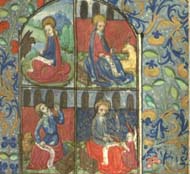Gospel Lessons
Depictions of the Gospel Writers in Books of Hours
Gospel lessons were normally included in Books of Hours. Since most individuals did not own or have regular access to a Bible, the gospel texts provided a way for laypeople to read some part of the life of Christ. Tthe Gospel excerpts were taken from readings used for the four major feast days: Christmas (John), the Feast of the Annunciation (Luke), Epiphany (Matthew), and the Feast of the Ascension (Mark).
In some manuscripts the four evangelists are shown together at the opening of the readings. Each is depicted in a separate quadrant, privately composing his Gospel. They would have been readily identifiable by their symbolic attributes. The symbols come from the "four living creatures" of Revelation and Ezekiel’s prophecy of the tetramorph, with the faces of an eagle, an ox, a man, and a lion. The association of each part with a specific evangelist is based on St. Ireneus' second-century analysis of the animals. The eagle symbolizes the spirit of the
life of Christ. Tthe Gospel excerpts were taken from readings used for the four major feast days: Christmas (John), the Feast of the Annunciation (Luke), Epiphany (Matthew), and the Feast of the Ascension (Mark).
In some manuscripts the four evangelists are shown together at the opening of the readings. Each is depicted in a separate quadrant, privately composing his Gospel. They would have been readily identifiable by their symbolic attributes. The symbols come from the "four living creatures" of Revelation and Ezekiel’s prophecy of the tetramorph, with the faces of an eagle, an ox, a man, and a lion. The association of each part with a specific evangelist is based on St. Ireneus' second-century analysis of the animals. The eagle symbolizes the spirit of the  Church, and is linked with John, a highly favored apostle. The ox, a symbol of sacrifice, is depicted together with Luke, while the angel (or man) symbolic of the Incarnation accompanies Matthew. Finally, the lion, a symbol of royalty as well as of fortitude and strength, is the attribute of Mark.
Church, and is linked with John, a highly favored apostle. The ox, a symbol of sacrifice, is depicted together with Luke, while the angel (or man) symbolic of the Incarnation accompanies Matthew. Finally, the lion, a symbol of royalty as well as of fortitude and strength, is the attribute of Mark.
The woodcut at the left depicts an event from the life of St. John the Evangelist as reported in the apocryphal Acts of John and in the popular medieval text, the Legenda Aurea, but it is an uncommon image to accompany the gospels in a Book of Hours. The Emperor Domitian has offered John a poisoned cup from which to drink as a test of the Evangelist's faith. John drinks the poison and lives, proving God's power on behalf of the faithful.
 The Virgin Mary
The Virgin Mary
Mary was a conduit through which the word of God became flesh. Church doctrine held that Mary was chosen by God because she was a vessel pure enough to bear his son. It was partly this notion that inspired people to pray to her to intercede with God on their behalf. Mary could not grant prayers, but it was widely believed that she could request favors from Jesus, and he, a dutiful son, would not refuse her wishes.
In the early 14th-century statue reproduced by these plaster casts, the Virgin is shown as a literal vessel, holding within her body the life of Christ. When the statue is opened, one can see scenes from the Passion Cycle - a series of images based on the gospel accounts of the arrest, trial, execution, and resurrection of Christ.

